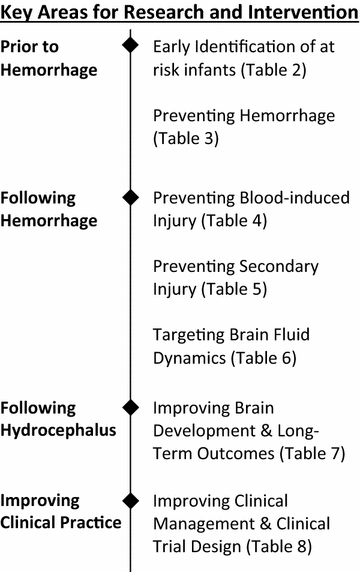Opportunities in posthemorrhagic hydrocephalus research: outcomes of the Hydrocephalus Association Posthemorrhagic Hydrocephalus Workshop
- PMID: 29587767
- PMCID: PMC5870202
- DOI: 10.1186/s12987-018-0096-3
Opportunities in posthemorrhagic hydrocephalus research: outcomes of the Hydrocephalus Association Posthemorrhagic Hydrocephalus Workshop
Abstract
The Hydrocephalus Association Posthemorrhagic Hydrocephalus Workshop was held on July 25 and 26, 2016 at the National Institutes of Health. The workshop brought together a diverse group of researchers including pediatric neurosurgeons, neurologists, and neuropsychologists with scientists in the fields of brain injury and development, cerebrospinal and interstitial fluid dynamics, and the blood-brain and blood-CSF barriers. The goals of the workshop were to identify areas of opportunity in posthemorrhagic hydrocephalus research and encourage scientific collaboration across a diverse set of fields. This report details the major themes discussed during the workshop and research opportunities identified for posthemorrhagic hydrocephalus. The primary areas include (1) preventing intraventricular hemorrhage, (2) stopping primary and secondary brain damage, (3) preventing hydrocephalus, (4) repairing brain damage, and (5) improving neurodevelopment outcomes in posthemorrhagic hydrocephalus.
Keywords: Blood brain barrier; Germinal matrix hemorrhage; Hydrocephalus; Intraventricular hemorrhage; Posthemorrhagic; Premature.
Figures


Similar articles
-
Outcomes of the 2019 hydrocephalus association workshop, "Driving common pathways: extending insights from posthemorrhagic hydrocephalus".Fluids Barriers CNS. 2023 Jan 13;20(1):4. doi: 10.1186/s12987-023-00406-7. Fluids Barriers CNS. 2023. PMID: 36639792 Free PMC article. Review.
-
Deferoxamine Prevents Neonatal Posthemorrhagic Hydrocephalus Through Choroid Plexus-Mediated Iron Clearance.Transl Stroke Res. 2023 Oct;14(5):704-722. doi: 10.1007/s12975-022-01092-7. Epub 2022 Oct 29. Transl Stroke Res. 2023. PMID: 36308676 Free PMC article.
-
Intraventricular hemorrhage and posthemorrhagic hydrocephalus in the preterm infant.Minerva Pediatr. 2010 Feb;62(1):79-89. Minerva Pediatr. 2010. PMID: 20212401
-
Alterations in protein regulators of neurodevelopment in the cerebrospinal fluid of infants with posthemorrhagic hydrocephalus of prematurity.Mol Cell Proteomics. 2012 Jun;11(6):M111.011973. doi: 10.1074/mcp.M111.011973. Epub 2011 Dec 20. Mol Cell Proteomics. 2012. PMID: 22186713 Free PMC article.
-
Fibrinolytic agents in the management of posthemorrhagic hydrocephalus in preterm infants: the evidence.Childs Nerv Syst. 1999 May;15(5):226-34. doi: 10.1007/s003810050378. Childs Nerv Syst. 1999. PMID: 10392493 Review.
Cited by
-
Research priorities for improving cognitive and neuropsychological outcomes in hydrocephalus.Fluids Barriers CNS. 2024 Dec 31;21(1):109. doi: 10.1186/s12987-024-00602-z. Fluids Barriers CNS. 2024. PMID: 39741311 Free PMC article. Review.
-
Does ventricle size contribute to cognitive outcomes in posthemorrhagic hydrocephalus? Role of early definitive intervention.J Neurosurg Pediatr. 2021 Oct 15;29(1):10-20. doi: 10.3171/2021.4.PEDS212. Print 2022 Jan 1. J Neurosurg Pediatr. 2021. PMID: 34653990 Free PMC article.
-
Rh-relaxin-2 attenuates oxidative stress and neuronal apoptosis via ERK-nNOS-NO pathway after germinal matrix hemorrhage in rats.Fluids Barriers CNS. 2025 Jan 15;22(1):8. doi: 10.1186/s12987-024-00616-7. Fluids Barriers CNS. 2025. PMID: 39815354 Free PMC article.
-
Rh-relaxin-2 attenuates degranulation of mast cells by inhibiting NF-κB through PI3K-AKT/TNFAIP3 pathway in an experimental germinal matrix hemorrhage rat model.J Neuroinflammation. 2020 Aug 28;17(1):250. doi: 10.1186/s12974-020-01926-x. J Neuroinflammation. 2020. PMID: 32859236 Free PMC article.
-
Endoscopic third ventriculostomy: a feasible treatment option for pediatric hydrocephalus in a high-risk cohort - a single-center report.World J Pediatr Surg. 2022 May 16;5(3):e000374. doi: 10.1136/wjps-2021-000374. eCollection 2022. World J Pediatr Surg. 2022. PMID: 36475044 Free PMC article. No abstract available.
References
-
- Rodriguez EM, Guerra MM. Neural stem cells and fetal-onset hydrocephalus. Pediatr Neurosurg. 2017;52:446–461. - PubMed
-
- Papile LA, Burstein J, Burstein R, Koffler H. Incidence and evolution of subependymal and intraventricular hemorrhage: a study of infants with birth weights less than 1,500 gm. J Pediatr. 1978;92:529–534. - PubMed
-
- Kazan S, Gura A, Ucar T, Korkmaz E, Ongun H, Akyuz M. Hydrocephalus after intraventricular hemorrhage in preterm and low-birth weight infants: analysis of associated risk factors for ventriculoperitoneal shunting. Surg Neurol. 2005;64:S77–S81. - PubMed
Publication types
MeSH terms
Grants and funding
LinkOut - more resources
Full Text Sources
Other Literature Sources
Medical

